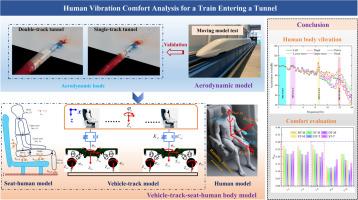列车进入隧道的人体振动舒适性分析
IF 9.4
1区 工程技术
Q1 ENGINEERING, MECHANICAL
International Journal of Mechanical Sciences
Pub Date : 2025-09-10
DOI:10.1016/j.ijmecsci.2025.110822
引用次数: 0
摘要
随着高速铁路网的快速发展,列车越来越多地在明线和隧道之间高速切换。这些突然进入狭窄的隧道空间会引起空气动力载荷的急剧变化,直接影响乘客的舒适度。为了研究高速列车隧道入口乘客的振动舒适性,本文提出了列车/隧道气动模型与列车-轨道-座位-人体耦合模型相结合的综合方法。其中,采用多刚体模型建立了列车-轨道-座椅-人的耦合模型,并通过振动试验台、全尺寸车辆试验和运动模型试验验证了两种模型的准确性。基于所建立的两种模型,得到了不同列车/隧道堵塞比和运行速度下车体和人体的振动响应。并对高速列车隧道入口流场特性进行了详细研究,为后续车体与人体共振效应的研究提供了理论基础。根据ISO 2631标准,对列车进入单线和双线隧道时不同车厢位置的人体振动舒适性进行了评价。上述分析对高速列车隧道入口乘客乘坐舒适性的正向设计具有重要意义。本文章由计算机程序翻译,如有差异,请以英文原文为准。

Human vibration comfort analysis for a train entering a tunnel
With the rapid advancement of high-speed railway networks, trains increasingly transition between open lines and tunnels at high speeds. These sudden entries into confined tunnel spaces induce sharp changes in aerodynamic loads, directly affecting passenger comfort. To investigate passenger vibration comfort during high-speed train tunnel entries, this paper proposes an integrated approach combining a train/tunnel aerodynamic model with a train-track-seat-human body coupling model. Among them, the train-track-seat-human coupling model is constructed using multi-rigid-body model, and the accuracy of both models is verified through a vibration test bench, full-scale vehicle experiments, and moving model tests. Based on the two established models, the vibration responses of the car body and the human body under different train/tunnel blockage ratios and operating speeds are obtained. Additionally, the flow field characteristics during high-speed train tunnel entry are studied in detail, providing a theoretical basis for subsequent research on resonance effects between the car body and the human body. The vibration comfort of the human body at different carriage positions is evaluated according to the ISO 2631 standard when the train enters single- and double-track tunnels. The above analysis is crucial for the forward design of passenger ride comfort during high-speed train tunnel entry.
求助全文
通过发布文献求助,成功后即可免费获取论文全文。
去求助
来源期刊

International Journal of Mechanical Sciences
工程技术-工程:机械
CiteScore
12.80
自引率
17.80%
发文量
769
审稿时长
19 days
期刊介绍:
The International Journal of Mechanical Sciences (IJMS) serves as a global platform for the publication and dissemination of original research that contributes to a deeper scientific understanding of the fundamental disciplines within mechanical, civil, and material engineering.
The primary focus of IJMS is to showcase innovative and ground-breaking work that utilizes analytical and computational modeling techniques, such as Finite Element Method (FEM), Boundary Element Method (BEM), and mesh-free methods, among others. These modeling methods are applied to diverse fields including rigid-body mechanics (e.g., dynamics, vibration, stability), structural mechanics, metal forming, advanced materials (e.g., metals, composites, cellular, smart) behavior and applications, impact mechanics, strain localization, and other nonlinear effects (e.g., large deflections, plasticity, fracture).
Additionally, IJMS covers the realms of fluid mechanics (both external and internal flows), tribology, thermodynamics, and materials processing. These subjects collectively form the core of the journal's content.
In summary, IJMS provides a prestigious platform for researchers to present their original contributions, shedding light on analytical and computational modeling methods in various areas of mechanical engineering, as well as exploring the behavior and application of advanced materials, fluid mechanics, thermodynamics, and materials processing.
 求助内容:
求助内容: 应助结果提醒方式:
应助结果提醒方式:


